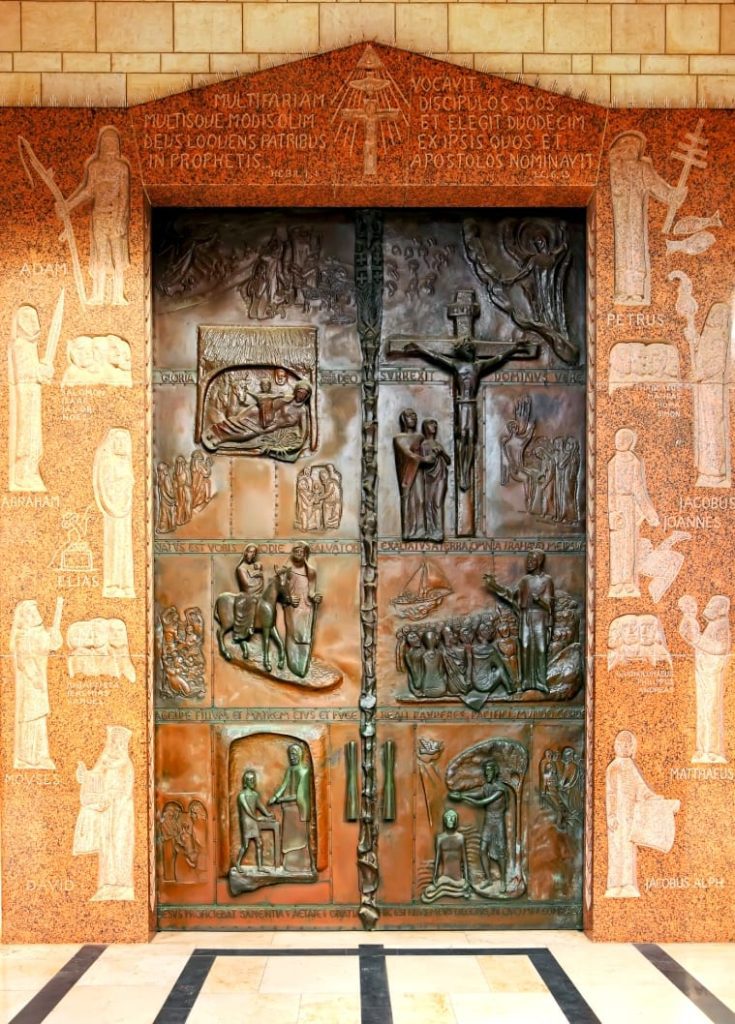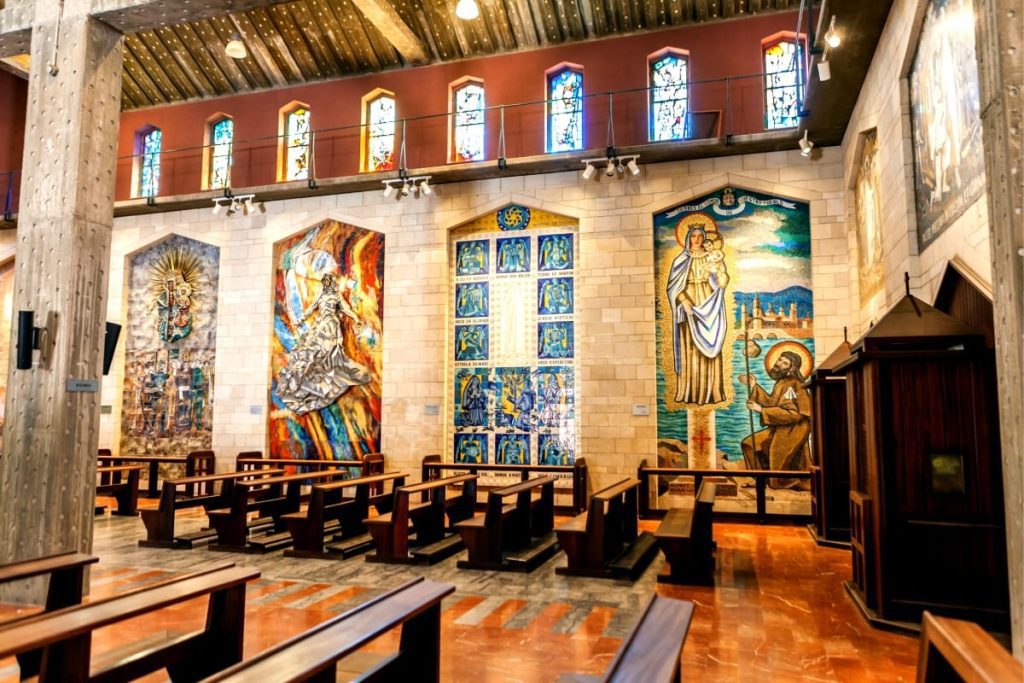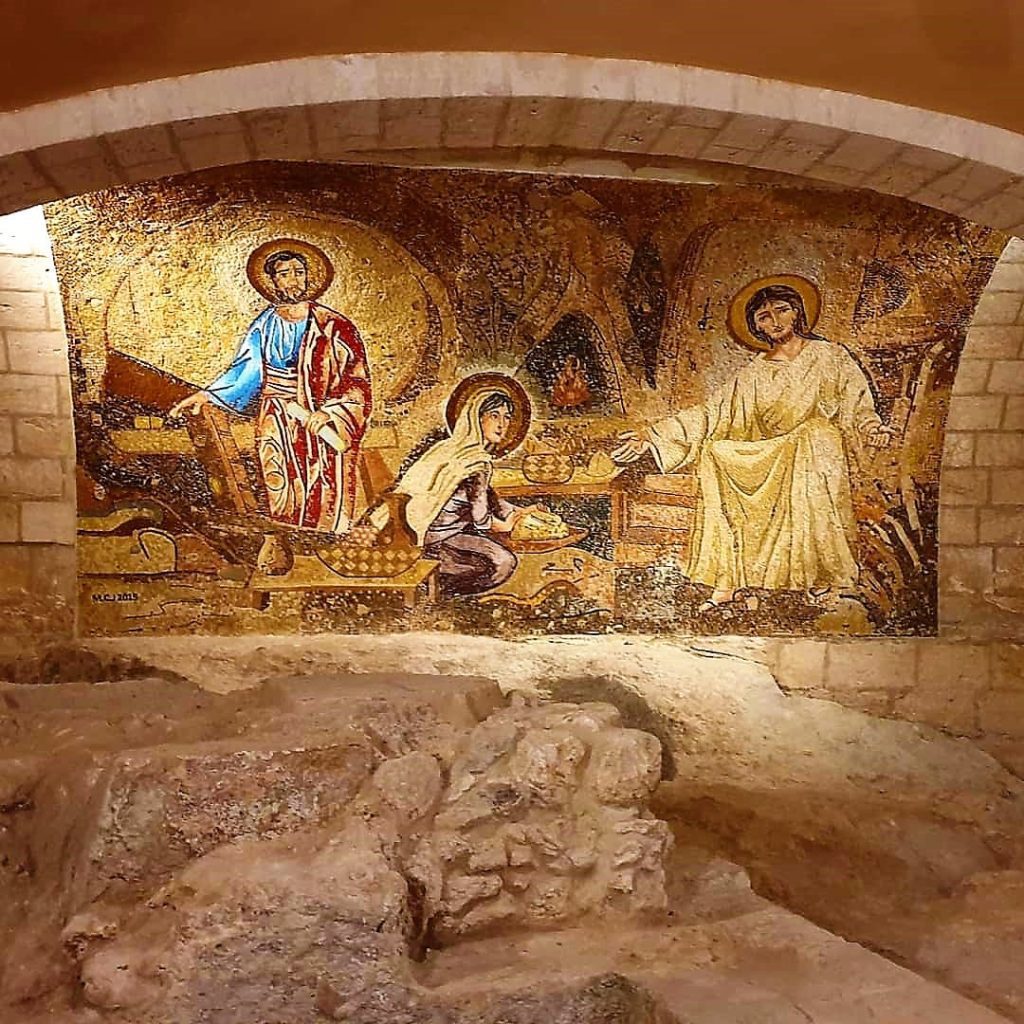The Basilica of the Annunciation, also known as the Church of the Annunciation is a basilica located in the center of Nazareth. It was erected on a site where according to Catholic Catholic tradition; stood the house of the Virgin Mary, and in which the angel Gabriel told her the good news that she was expected to conceive and carry in her womb Jesus; the Son of God. For this reason; the Basilica of the Annunciation, and even the city of Nazareth, is among the most sacred places in the Christian world.

Archaeological Remains
Archaeological excavations at the site have uncovered the remains of three earlier churches; which stood on the site one after the other, and in fact, the site served as a place of worship even before the time of Christ. The site was located in the south of the ancient village of Nazareth, and in addition to the houses of worship, the study also revealed the remains of residential buildings, wells, and barns.

The current structure was designed for the custody of the Franciscan Holy Land by the Italian architect Giovanni Muzio; and the basilica was inaugurated in 1969. The construction was carried out by the Israeli company Solel Boneh and the chief engineer was Engineer Shlomo Loftin. It is visible from afar by a large gray cone dome; topped by a lighthouse-like lamp. Among other things, the basilica complex also houses the Franciscan monastery and the Church of St. Joseph. The basilica is the most prominent building in the city and its best-known landmark.

Basilica of the Annunciation – Christian Tradition
The Annunciation to Mary is described in the New Testament in the Gospel according to Luke:
26 In the sixth month of Elizabeth’s pregnancy, God sent the angel Gabriel to Nazareth, a town in Galilee, 27 to a virgin pledged to be married to a man named Joseph, a descendant of David. The virgin’s name was Mary. 28 The angel went to her and said, “Greetings, you who are highly favored! The Lord is with you.”
29 Mary was greatly troubled at his words and wondered what kind of greeting this might be. 30 But the angel said to her, “Do not be afraid, Mary; you have found favor with God. 31 You will conceive and give birth to a son, and you are to call him Jesus. 32 He will be great and will be called the Son of the Most High. The Lord God will give him the throne of his father David, 33 and he will reign over Jacob’s descendants forever; his kingdom will never end.”
34 “How will this be,” Mary asked the angel, “since I am a virgin?”
35 The angel answered, “The Holy Spirit will come on you, and the power of the Most High will overshadow you. So the holy one to be born will be called the Son of God. 36 Even Elizabeth your relative is going to have a child in her old age, and she who was said to be unable to conceive is in her sixth month. 37 For no word from God will ever fail.”
38 “I am the Lord’s servant,” Mary answered. “May your word to me be fulfilled.” Then the angel left her.
Gospel of Luke 1:26-38
The Catholic Tradition vs Orthodox Tradition
So the Catholic tradition concluded that the annunciation was held in the room of the virgin. And therefore placed the event in the residence of Mary and St. Joseph. On the contrary, the Orthodox preferred the version according to which the annunciation took place near Mary’s Well in the north of the Old City of Nazareth, as stated in the Gospel of James:
“And she took the pitcher and went forth to draw water, and behold, a voice said: ‘Hail Mary, full of grace, you are blessed among women.”
Gospel of James
Near the spring stands the Church of St. Gabriel, named after the angel.

More About Archaeological Research on the Site
Firstly, most of the archaeological research at the site was made possible when the previous Church was demolished in 1954 to make way for the current Basilica of the Annunciation. Furthermore, this study lasted from 1955 to 1968, near the completion of the construction of the basilica. However, the very existence of the early structures at the site, as well as some of the finds; is known from excavations that took place in the late 19th and early 20th centuries.
So some of the finds are on display in the museum housed in the Franciscan monastery building in the compound, and the remains of the buildings themselves are located below the level of the northern extension and can be viewed on-site. Moreover, in 2009, the remains of a residential building dating to the 1st or 2nd century near the basilica complex were discovered.

Early History of the Site
Remains of an early Judeo-Christian cult structure were discovered at the site, including a primitive baptismal font, a mosaic floor, and a staircase with seven steps; which led to the Cave of the Annunciation. Another cave, which also served as a place of worship, was exposed west of the remains of the building. The mosaic floor of this cave was engraved with the inscription “To Konon, Deacon of Jerusalem”; and graffiti and four to six layers of decorated plaster were discovered on its walls.

The lower layers of plaster date back to the middle of the 4th century; and they depict flowers and plants; which researchers believe served as an allegory for heaven. An inscription written in large letters in red was discovered on one of the walls, and the formula was: “Lord, Jesus, help your servant Valeria … and give relief to the pain … Amen.”
Also, a number of inscriptions discovered at the site showed that the site was a place of worship of Mary; at least in the early 4th century. At the base of a nearby pillar was discovered a Greek inscription “XE MAPIA”. In English “Hail Mary”. This inscription, which commemorates Gabriel’s blessing on the Virgin; predates back the Ephesus Conference in 431, the ecumenical conference that recognized Miriam’s status as “Mother of God.”

The Site During the Byzantine Period
During the Byzantine period, a church was built on the site, dating to 427 CE. Moreover, the building had three naves and a single apse. The length of the central nave was 19.60 meters from east to west, and its width was eight meters. The Annunciation Cave was located outside the church building on its northern side. Hieronymus visited the church at the end of the 4th century and noted this in his writings, which indicates that the site was designated for pilgrimage already in those days.

This structure was maintained and renovated for at least two centuries, and Antoninus of Piacenza visited it in 570. It seems that the structure was destroyed; at least in part, by the Arab Conquest; after they conquered the land in the early 7th century. When St. Willibald visited Nazareth in 725, there wasn’t any worship in the church. But it was revived in the early 8th century. Furthermore, the Muslim historian and geographer al-Masudi also found the church abandoned in 943; and the complete end of the structure came to him in 1010.
In the Crusader Period
Then Tancred, Prince of Galilee, conquered Nazareth in 1099; and began building the Crusader church beginning of 1101. It was much larger than the building that preceded it. In fact, it was even slightly larger than the current basilica. A Russian monk named Daniel, who made a pilgrimage to Nazareth in 1106–1107, described “a large and wide church, with three altars.” The length of the building reached about 50 meters and its width was 30 meters. Also to the south, a monastery was erected, and to the west, an atrium led to it.

Furthermore, the church was divided into three naves by two rows, each of which had six massive pillars. At the eastern end of the building were set three apses – the central one wide and long on both sides. Additionally, the Cave of the Annunciation was this time included in the area of the church; and was housed in its northern (left) nave. The Crusaders left the elevated rock where the cave resides in its state and erected above it a small altar and a staircase that led to the cave itself.
The church is richly decorated and had at least 64 capitals. Five Romanesque-style capitals that were found just lying around on the site indicate that the structure was never completed. In 1263 the Crusader church was demolished by the order of the Mamluk Sultan Baibars. At some point after that, a small chapel was erected on the site that protected the Cave; and this situation remained the same for about 400 years.
The Modern Basilica of the Annunciation
The design of the new basilica was first entrusted to the renowned Italian architect, Antonio Barluzzi, who built a number of churches in Israel and around the world. Barluzzi began work in 1939 on the preparation of a detailed plan for the church. But in 1958 the project was handed over to architect Giovanni Muzio, also an Italian, who formulated a new plan for the building. This plan was approved in 1959 and on September 30, 1960, the services of the Israeli construction company Solel Boneh were hired. During his visit to Israel in 1964, Pope Paul VI inspected the site. Construction work continued for over eight years, and the basilica was dedicated to the Feast of the Annunciation, which took place on March 25, 1969. Two days later, another ceremony was held with the participation of representatives of non-Catholic Christian denominations.
The Compound of the Basilica of the Annunciation
So the Basilica of the Annunciation stands on al-Bishara Street (“The Annunciation” in Arabic); the main street of the Old City of Nazareth. The Basilica of the Annunciation stands on the southern side of the compound. To its north is a large plaza that stands on pillars and below it are the remains of the ancient village of Nazareth in situ. On the eastern side of the compound stands the building of the Franciscan monastery first erected in 1620. In 1930 the building was demolished, and under it, the present structure.
Church of Saint Joseph in Nazareth
North of the monastery is the Church of St. Joseph, and according to medieval tradition; it was established on the site of the workshop of Joseph, who was a carpenter by profession. The present church building was erected in 1914 on the outline of the former Crusader church and its Neo-Romanesque style. Next to it stands a square bell tower bearing a red roof.

No doubt, the Basilica of the Annunciation is the most unique and prominent structure in the city of Nazareth; and in its forty years of existence, it has become the most recognizable symbol of the city. Furthermore, the basilica is built of two large levels that are entirely different from each other; their quality of lighting, and the atmosphere they soak up.
Furthermore, the lower level, or crypt, preserves the Annunciation Cave and the ancient remains found beneath the basilica; and the level above it is a modern church. In fact, the two levels are connected by a large opening in the ceiling of the crypt (church floor); which is shaped like an octagonal shape. Moreover, the opening is below the dome of the building, and in fact, it is an open shaft that unites all the parts of the basilica.








